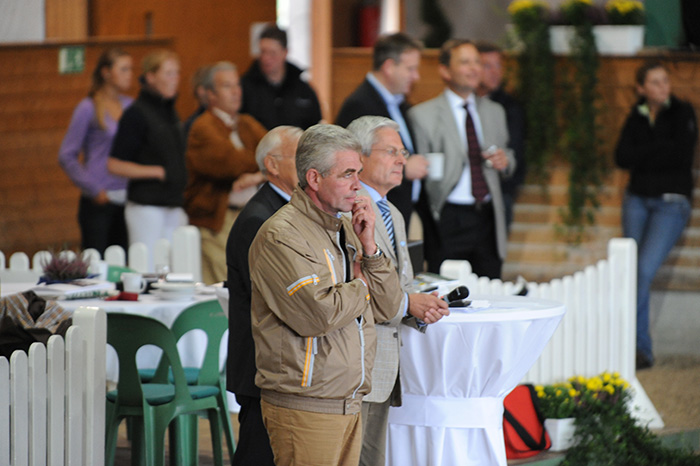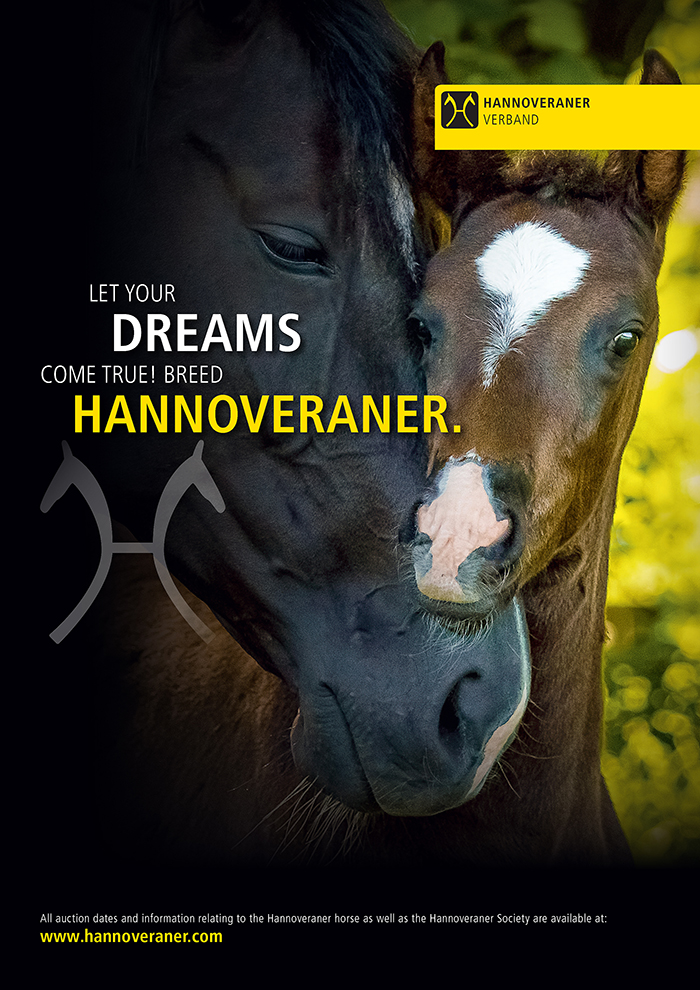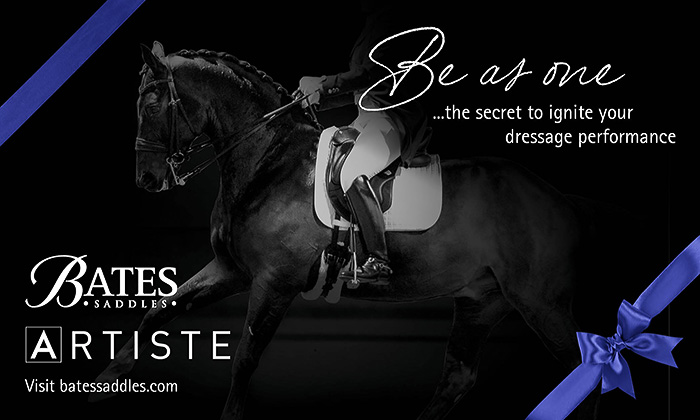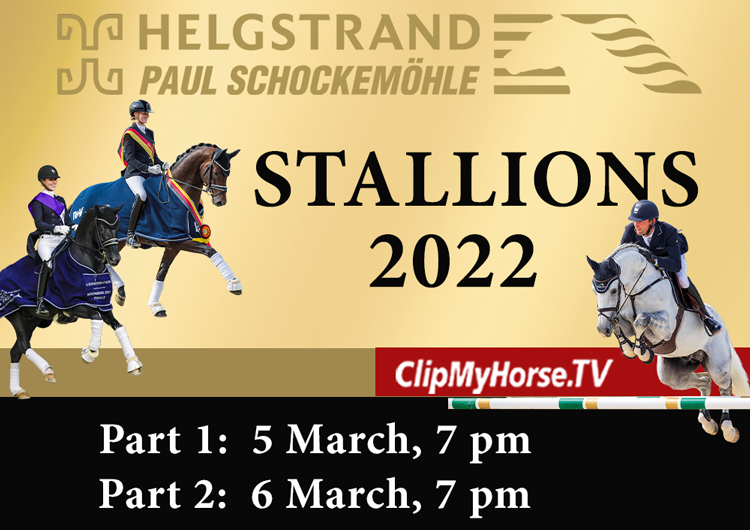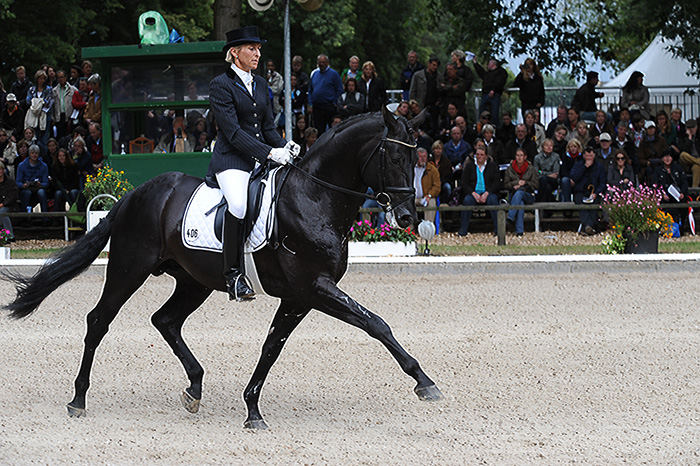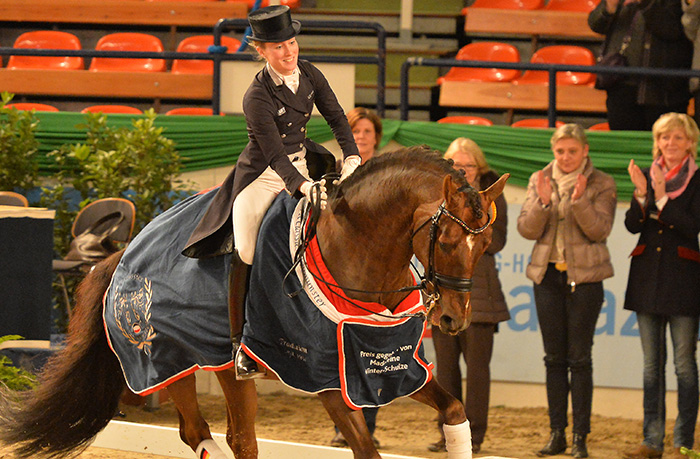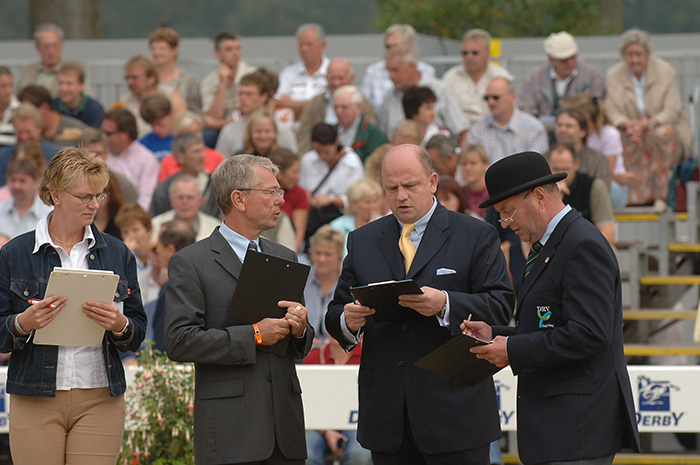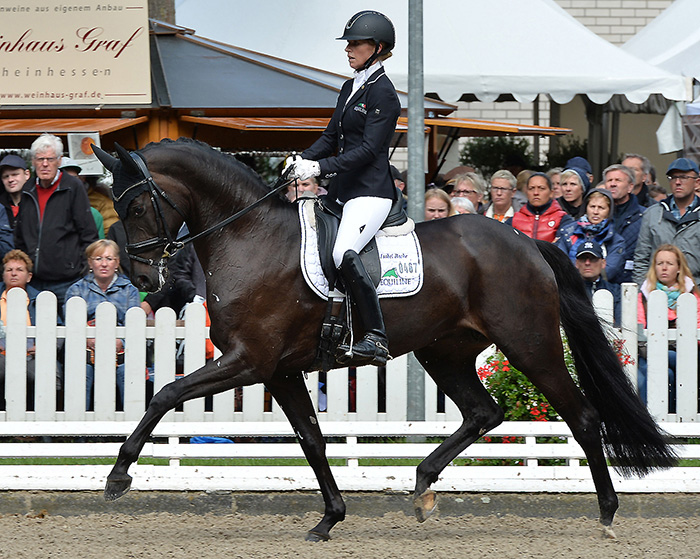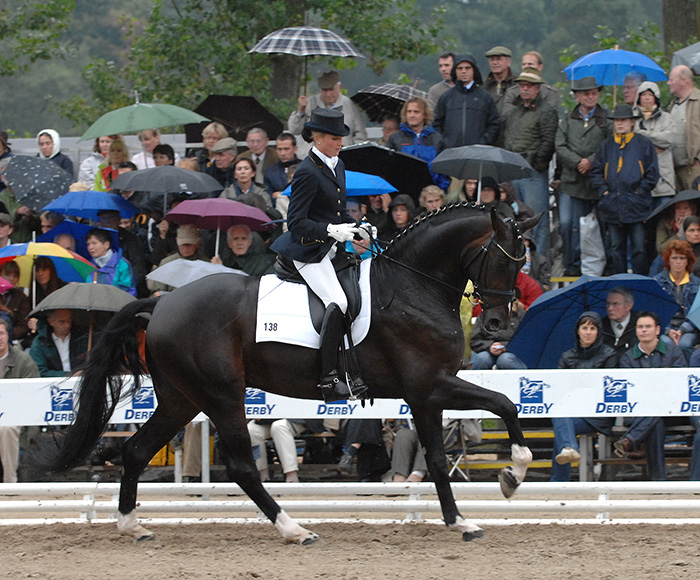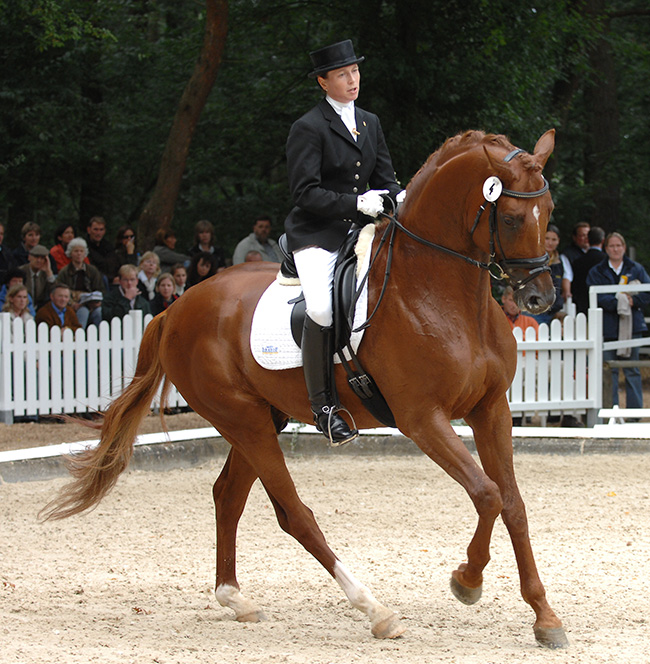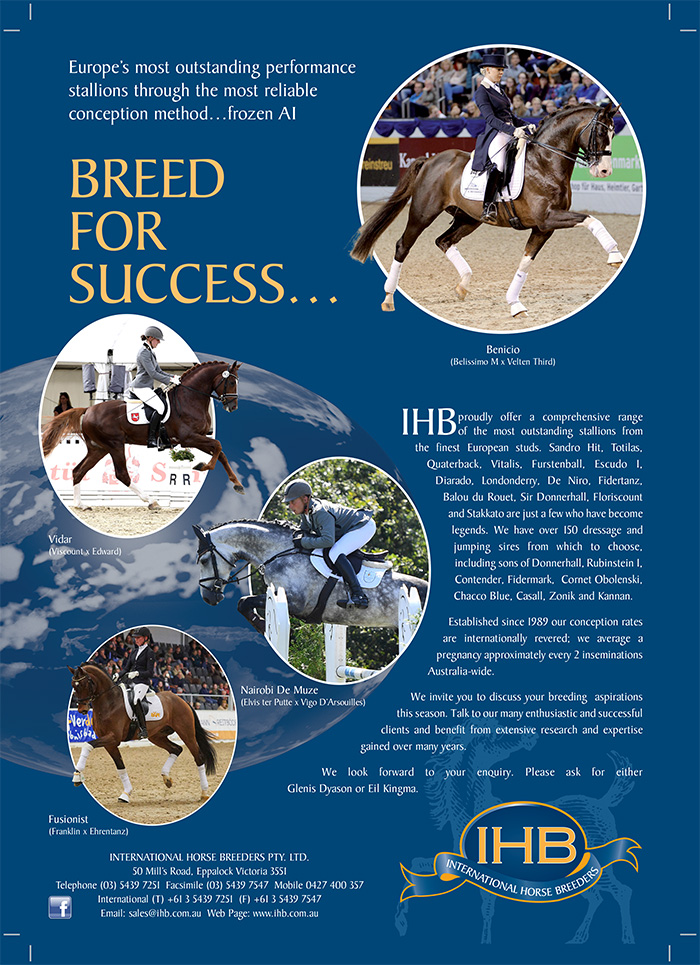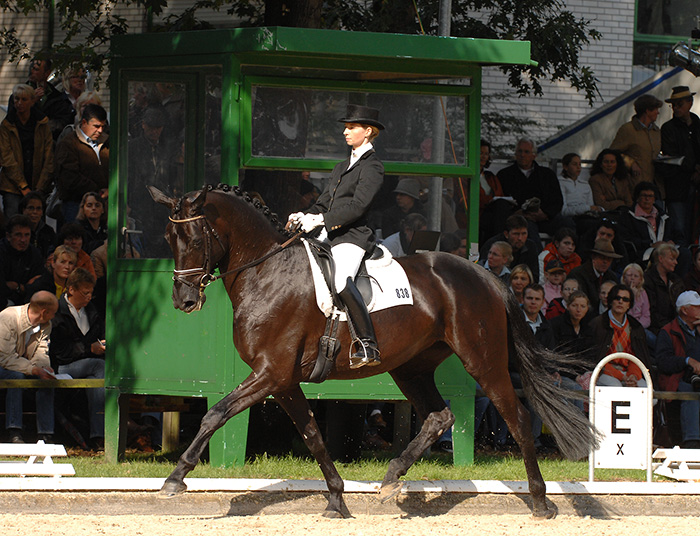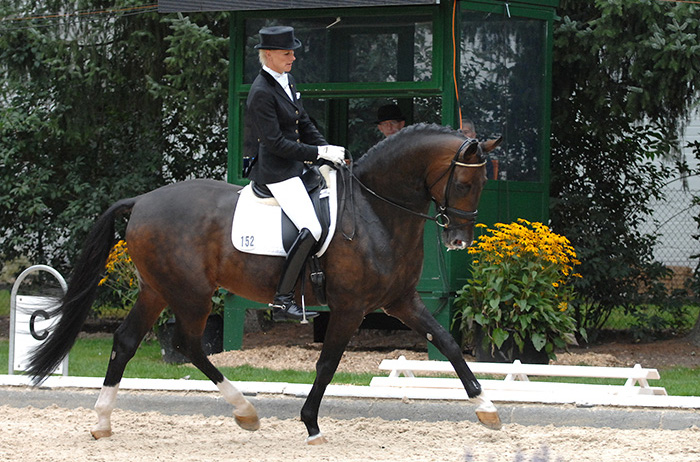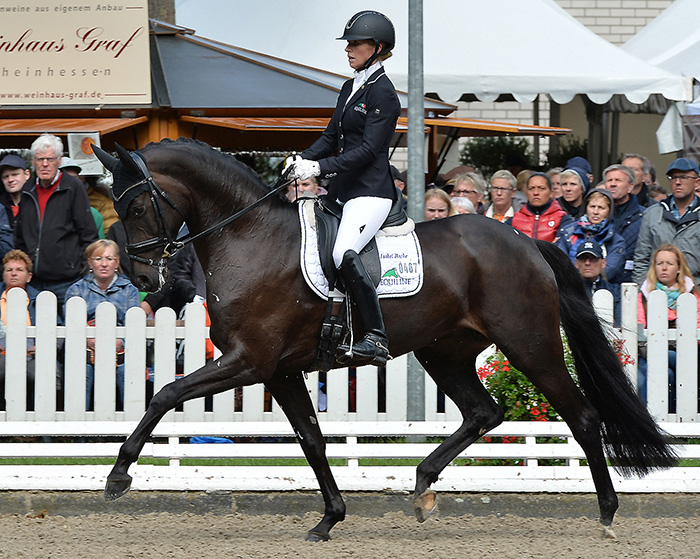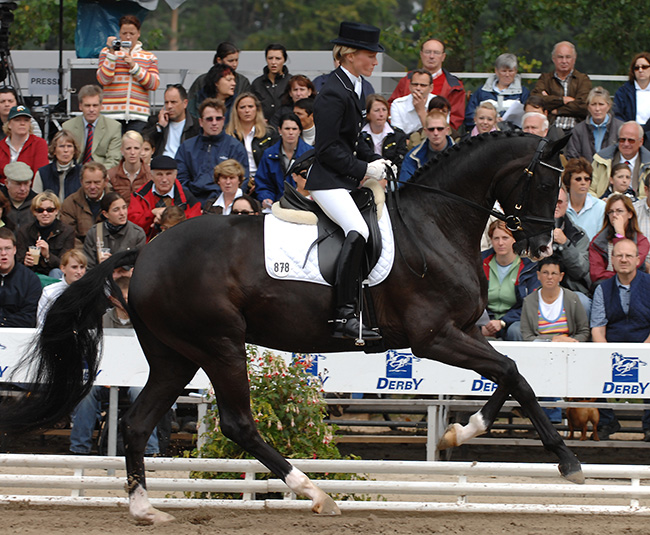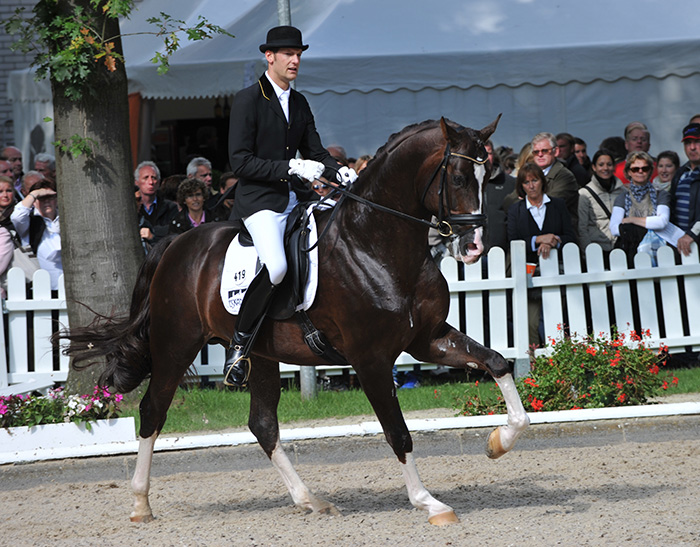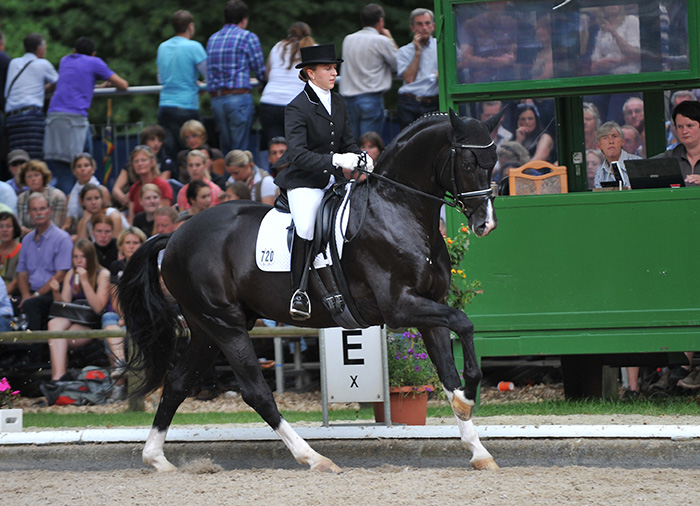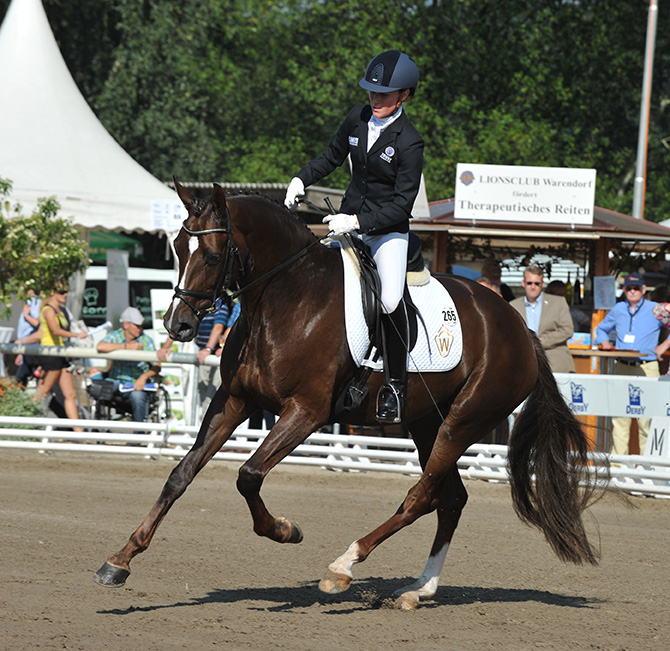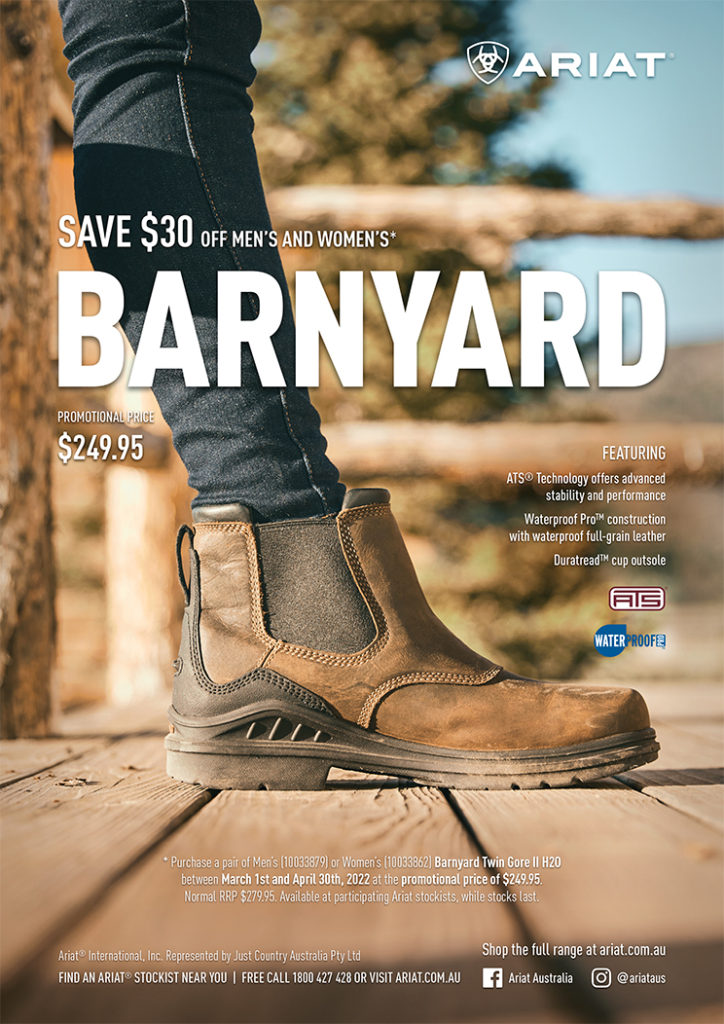The Young Horse in Action
It is still the best seminar I have ever attended – brilliantly organized by Christoph Hess in 2009 in Warendorf, it featured a star studded lineup of riders, horses, judges and experts – like the master trainer, Hans-Heinrich Meyer zu Stohen working with some exceptional youngsters.
The first was a young mare, Paola (Lord Loxley out of Poetin II by Sandro Hit) ridden by Christian Flamm. Hans-Heinrich Meyer zu Strohen who trains Christian, explained where they were at with the youngster. She had been started in January and first lunged for a couple of months. Now she was being worked under saddle, but still with the rider in a forward seat and really short spurs.
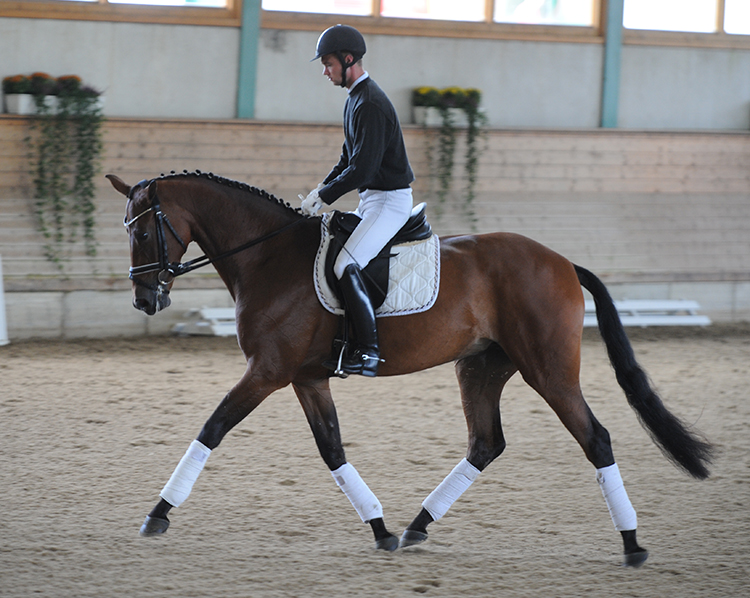
“Right from the beginning, the contact must be absolutely clear,” Hans-Heinrich stresses. “First on both reins equally, then more to the outside rein. Try to get the reins a little longer, work on the rhythm and the position of her neck. If you get the neck too high, then later you have problems – if you ride them this way, you don’t need a vet.”
“At this stage we just want her to canter forward – later we will make her straight. Use the short side to get a little more activity, we don’t want a running canter, just round, round, round. In the beginning the horse must learn to accept the leg and go forward in the transition.”
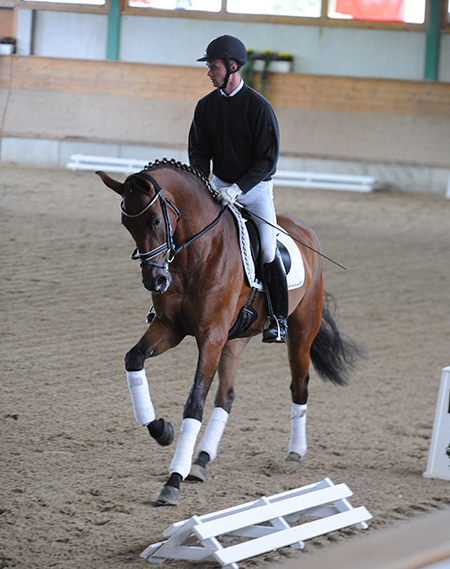
The seminar moderator, Christoph Hess points out: “Here we see rhythm, including the right tempo; suppleness/relaxation and contact. The first three things on the training scale are the most difficult to get!”
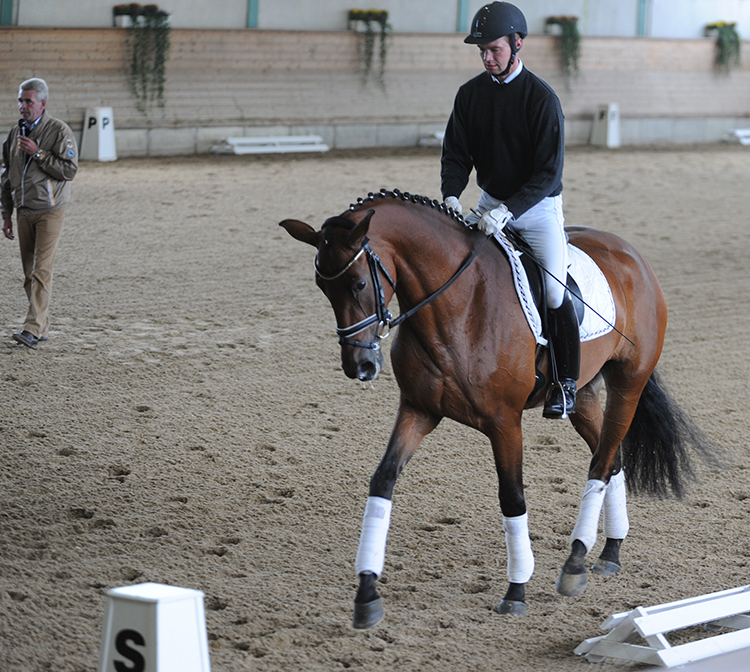
story continues below the advertisement
The next horse in was a four-year-old Hanoverian, Horatio by Hochadel out of a Matcho mare, ridden by Dorothee Schneider, one of those consummate German professionals who rides at every level, from babies to Grand Prix.
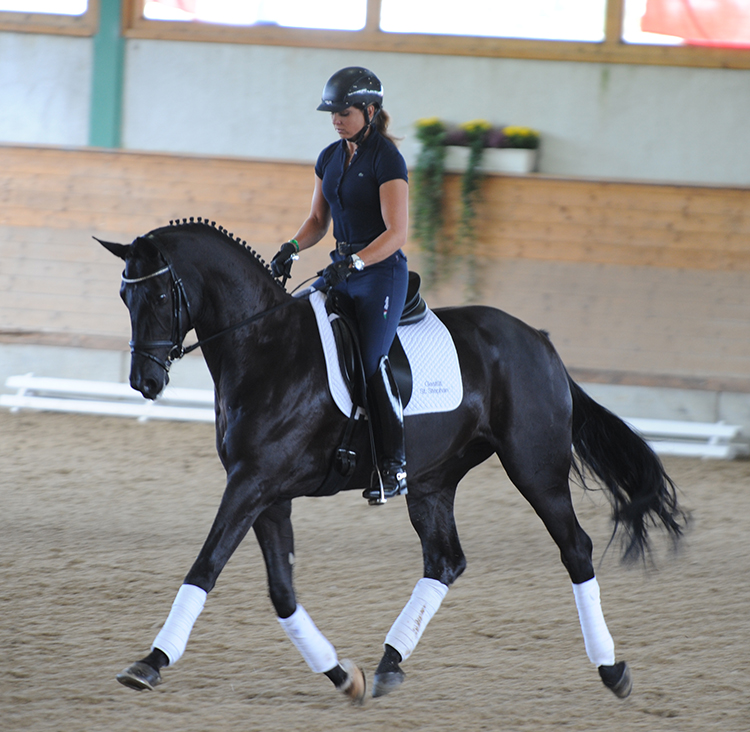
Longer strides, not medium for three and four-year-olds – Dorothee Schneider and Horatio demonstrate…
The commentator was the judge (and former Grand Prix dressage competitor) Dietrich Plewa: “It is very important to find the right speed for each horse. In the conformation classes (ie. Riding horse classes for three and four year olds), we have serpentines to see if the horse can keep the balance – the same speed, same rhythm. Now show some longer strides. In conformation classes, we don’t ask for medium only longer strides…”
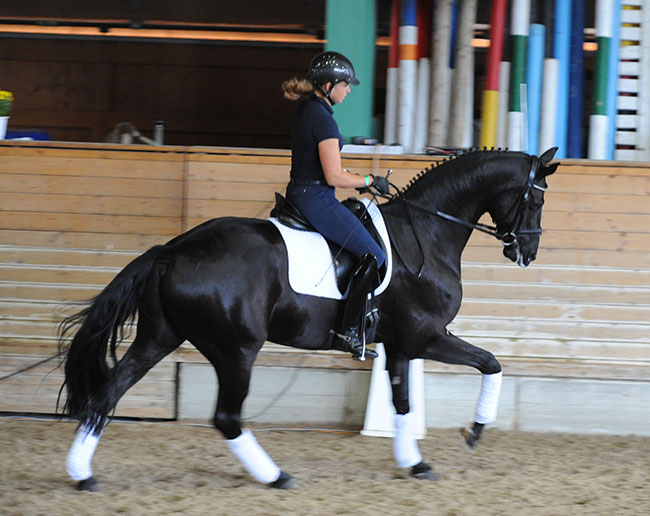
Horatio and Dorothee demonstrate canter…
At this point I am struck by the appearance of ‘clinic talk’. You know, at the judges clinics they all talk about using the full range of their marks and going really high and really low, and when they get to the competition, we are back in the 6s and 7s. In the coffee break I pointed out to Dr Plewa, that the winner of the three year old stallion class at the previous day’s Bundeschampionate, had been shown at what could only be called an exaggerated extended trot. Dr Plewa made the point that he hadn’t judged that class but agreed that it was unfortunate that some riders interpreted ‘longer’ as flat out. Treat it like an error of course, I suggested. But I suspect they won’t.
“In the canter, our first criteria is the three beat rhythm and clear uphill tendency. When we lengthen the rein, is the horse able to keep that uphill tendency and the rhythm – and not change speed even after the reins are shortened.”
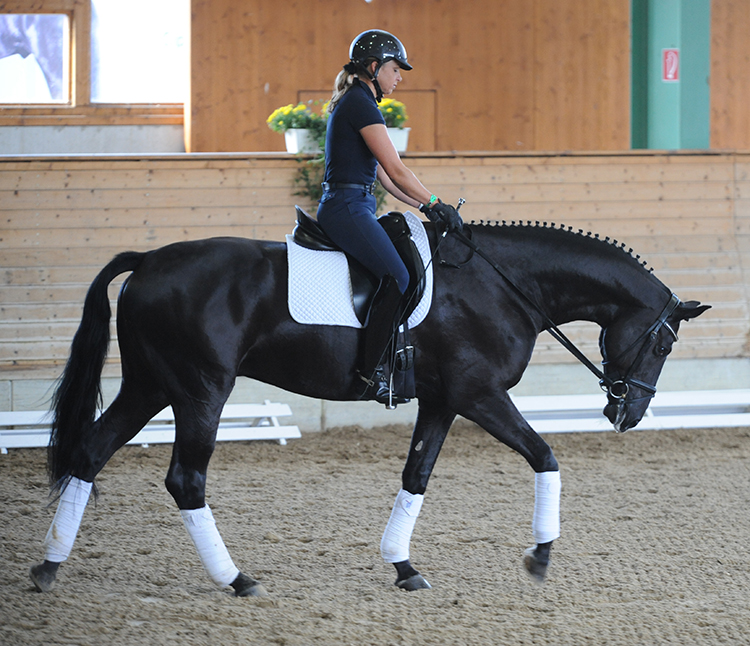
Movement through the WHOLE body, Horatio and Dorothee in walk
“The walk should be clearly four beat and it is very important that the movement should be through the horse’s WHOLE body – the horse should be marching from one point to the other. In the conformation class, long reins are not loose reins – if the reins are too long, the judge can say, please shorten the reins.”
another horse follows
The next horse was another four year old, this time the Rhineland stallion, Don Jerome (Damon Hill / Guy Laroche) ridden by a professional from the south of Germany, Uta Gräf
The next rider demonstrated how important it is for the horse to be well-balanced. According to Uta, ‘my hands are listening to the horse, small transitions are the key points for schooling the horse…’
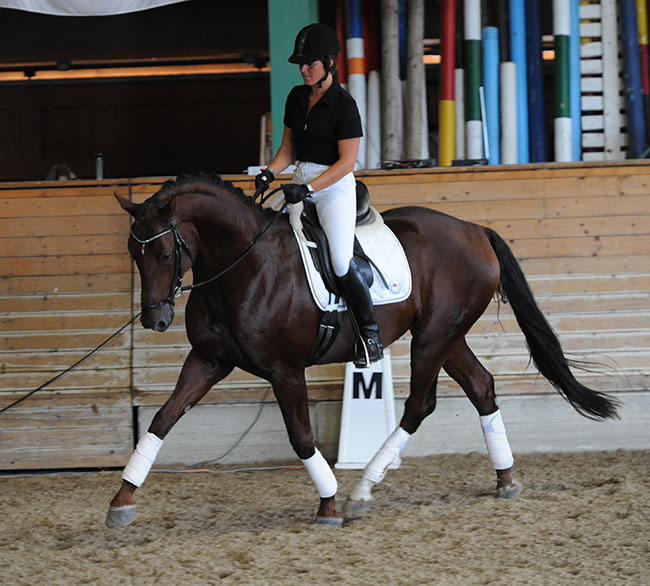
Christoph Hess was (as usual) enthusiastic: “Here we have a rider in a well-balanced position in the saddle. A rider who can develop the horse and make it happy. A rider not using spurs, not using the whip, just asking the horse with body language. The only negative point is the horse’s mouth is too dry, but she is able to ride with long reins and can play with her position. When you school a horse, you have to have a clear vision – this is how it works when you are supple and well balanced.”
Dr Plewa made the point: “this is a horse in a really good rhythm. It is a big horse but you see him, you don’t hear him.”
More follows
The Theory
One of Germany’s most respected young dressage horse judges, Dr Dieter Schule oulined the judging guidelines for Young Horse classes…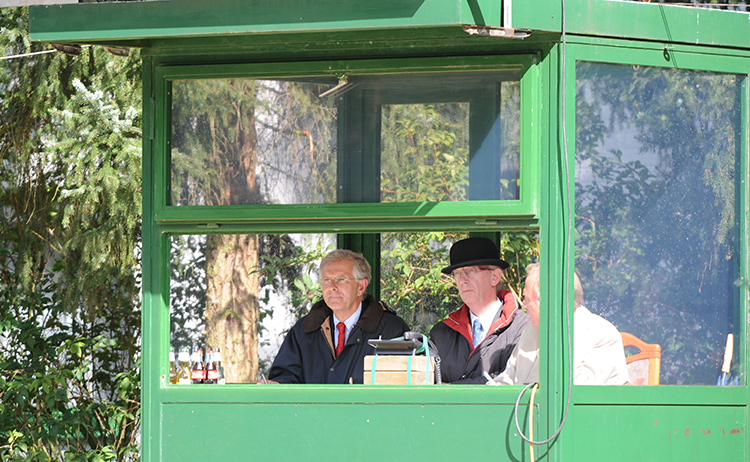
In the judges’ stand, Christoph Hess and Dieter Schüle
The view from the Judges’ Stand
As one of the key note speakers at the Bundeschampionate Seminar, Dr Schüle’s paper, Dressage Horses – from a Judge’s Perspective set the framework. Dr Schüle started by talking about the way in which the three of the ‘stake-holders’ interact in the process: the breeder, the rider, the judge, and the correct conformation for the dressage horse.
“Each rider / breeder aims at the ideal horse which has a perfect conformation, charisma, medium frame and expressive gaits.”
From the breeders’ point of view the ‘product’ should demonstrate correctness and expression. Dr Schüle suggested that breeders tended to under-estimate the value of performance on the part of the mare, and over-estimate the value of the stallions which are ‘in vogue’. It was dangerous to breed to high priced, highly advertised stallions, who when their progeny at the age of three or four showed problems, immediately disappeared…
Dresden Man, a Bundeschampion
From the riders’ point of view, the good horses were those which are easy to handle and comfortable to ride. Again, he suggested that the breeders often under-estimated the importance of temperament, character and motivation in the horses, and produced horses that were difficult to handle. For the rider, a good horse is fun.
“Breeders should work together with riders and trainers and get a feedback about character, temperament and motivation.”
In the middle of all this was the Judge who had a crucial role:
“The judge has to evaluate the horse’s performance and should give direction for improvement of the – horse, training, and, the rider.”
The Dressage Horse should be:
* Of medium size – 1.70m (16.3hh) – with correct anatomy
The ideal: * Uphill conformation * Long legged * A balance between a square frame and a rectangular frame – the rectangular, long horse could have problems with the hindlegs, while a horse that was too short and square, could have problems with suppleness * A well developed croup, since this is the motor of the horse.
However, Dr Schüle did flash up on the screen photos of Rembrandt and Gigolo to demonstrate that ‘deficiencies in conformation can be compensated by training.
The neck: Should be naturally uphill and arched; Smooth transition from the neck to the head through the throat latch; Adequate length of neck – too short, problems with contact, too long, difficulties in keeping the poll as the highest point; The muscles should be on the upper side of the neck; the origin of the neck at the shoulder was of particular importance, the neck should come high out of the shoulder and be strong enough – muscles can be developed, but the origin of the neck cannot be changed.
The forehand – Regulating Ground Cover
* 60% of the horse’s weight is on the forehand by nature but by correct training this is changed with increasing collection. Long front legs are desirable and the Thoroughbred is important in producing these longer legs.
* The Shoulder should be long and sloping for a better ground cover. The shoulder is important because it influences the position of the saddle – too steep and it forces the saddle back.
* The importance of the Upper Arm is often under-estimated. A long upper arm is important for good ground covering.
* The elbow is important and enough space between it and the body is necessary for the horse to execute the lateral movements. When the elbow is tight to the body, the horse has no freedom of movement. It’s good if you can place your hand between the horse’s elbow and its body.
* The position of the front legs, they must be correct and straight. The fetlock is important for elasticity.
read on below
The back / loin – The Bridge
The longer the back, the more problems the horse will have with engagement. The top line of the horse should be straight, not hollowed and not too high at the croup.
The hindquarters / croup – carrying weight: ‘The Motor”
The croup should be well shaped with developed muscles, it should be long enough with the correct angles of the haunches.
Problems: A high tail set with the hindlegs standing out behind leads to not enough engagement
Correct angles and development of the muscles are a good precondition for the activity of the hindquarters. The angle should be 90 degrees with the hocks under the horse. Hocks that are too close together have trouble carrying weight.
The Basic Gaits should show: * clear rhythm * relaxation * Elasticity – swinging back * Good impulsion (not walk) * Balance * Active, bending joints of hindquarters * Good freedom of shoulder
The walk should show a clear four-beat rhythm. A steady rhythm not ‘short and long’. Activity – a powerful push-off, out of the hindlegs – not too slow and laboured or fixed in the back. The judges are looking for good Ground Cover – many judges just look at the over-step and not forget to look, is the horse coming out of the shoulder? Is it keeping the rhythm? Is the horse showing relaxed muscles in the back and along the top line? Is the horse accepting the bit and not throwing off the reins. Problems: fixed in the back, stiff front legs. Rhythm is more important than over-stepping, over-stepping too much can cause problems, two hoof widths is enough. The idea that two hoof widths overstep is worth 7, four widths is worth 9, is not correct.
The trot should be in a clear two beat rhythm, showing suppleness and a relaxed, energetic elastic swinging back. The horse should show mental calmness – a ‘happy’ attitude. Problems arise when there is a repeated loss of rhythm especially in the movements and turns, and an unevenness of the steps, or when the trot looks tense, forced or unnatural. The impulsion should come from a natural movement of suspension – not a fixed back. There should be a powerful push-off of the hindlegs, with active bending in the direction of the point of gravity. The hocks should be engaged and under the horse. Problems: not enough basic impulsion, stiff hindlegs – not bending, hock too high and behind the horse, extreme action of frontlegs not in relation to hindlegs.
The judge wants to see not only ground cover – from active hindlegs with good freedom of shoulder – but also a talent for collection – natural talent for self-carriage and carrying power of the hindquarters.
The canter: Here the judge wants to see a clear three-beat rhythm on both reins. The inside hindleg must show bending of the hock and act towards the point of gravity, but the outside hindleg must also be engaged. Problems: No clear rhythm, stiff hindlegs without active haunches. The judge also wants to see a bending ‘round’ frontleg because this helps in the collection and the changes. He is looking for an uphill tendency with self-carriage and balance.
Problems: Coming on forehand, high croup, stiff frontleg.
Rideability: The correct training of a dressage horse should be in relation to the scale of training and all steps of the scale should be fulfilled in the right order.
The quality of a dressage horse: Temperament, willingness to perform, character, learning aptitude. A sensitive horse which is eager to go forward is preferred to a lazy and unmotivated horse. Young horses can be spooky but still good for dressage.

